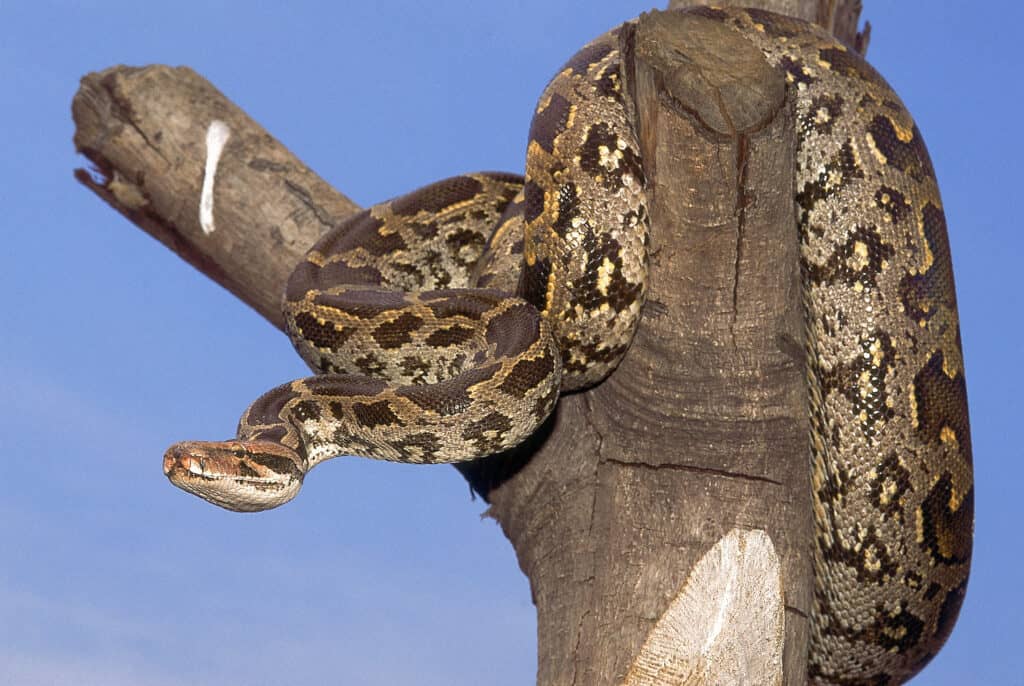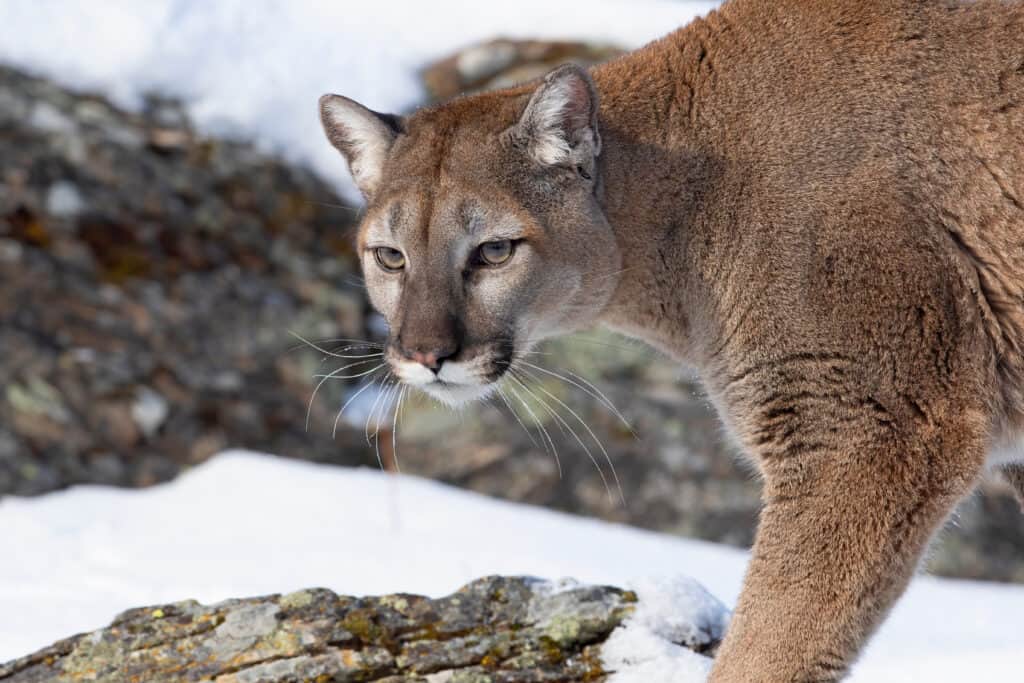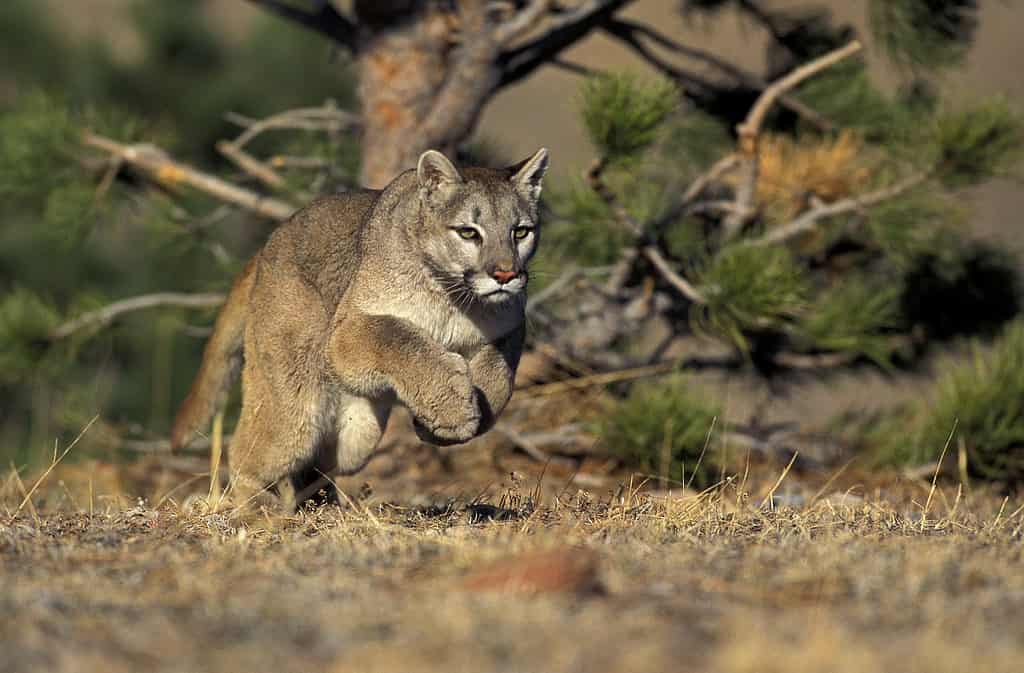It’s a python vs. mountain lion battle! Who will emerge victorious? The sneaky reptile or agile mammal?
Pythons are one of the strongest and largest snakes in the world, with the largest reticulated python weighing over 500 pounds. On the other hand, mountain lions are known for their fierce hunting skills, and the biggest mountain lion weighed 276 pounds!
Both of these challengers are big and strong. To determine who deserves the championship title we’ll look beyond their physical stat, taking into account each species predatory and survival skills. What happens when a python tries to fight a mountain lion? Read on to find out.
Pythons

It’ll take this snake a while to slither into the ring, but it’ll be ready to fight once it does.
©iStock.com/ephotocorp
Introducing our first species in this animal matchup, the python. Pythons are constrictor snakes. Instead of venom, they use their large coils to squeeze their prey to death. Squeezing the life out of prey is easy thanks to their long, muscly bodies.
A rock python is nearly as long as a stretch limo! It’ll take this snake a while to slither into the ring, but it’ll be ready to fight once it does. These snakes have 100 sharp rear-pointing teeth that help them swallow their prey whole. Unhinging its jaws, the rock python’s cheeks can stretch wide enough to swallow a small child!
Mountain Lion

Mountain lions are fierce hunters, capable of taking down large prey like elk and deer.
©Jim Cumming/Shutterstock.com
Let’s welcome our second challenger, the mountain lion. Mountain lions have an average weight of 136 pounds but can get much larger. In North America, their staple diet includes deer, which they hunt using a keen sense of sight and hearing.
Mountain lions are fierce hunters, capable of taking down large prey like elk and deer. Their agility helps them gain an advantage. These big cats can leap 40 feet through the air, pounce on unsuspecting victims, and sever the spinal cord with one bite. Ouch! Sometimes these big cats eat their kill right at the death site, other times they carry it away to store as leftovers.
Python vs. Mountain Lion: Battle Chart
| Battle Factors | Python | Mountain Lion |
|---|---|---|
| Physical Stats | 10 to 28 feet long 200 pounds 1 mph land 3 mph in water | 3 to 6 feet long 136 pounds 10 mph for long distances 30 mph for hunting 50 mph top speed Can swim one mile |
| Predatory Skills | Death by squeeze Painful non-venomous bite Excellent tree climber | 2-inch-long claws 2-inch-long teeth Severs spinal cord Suffocates Excellent tree climber |
| Survival Skills | Camouflage Ambush hunting Hiding to evade threats Solitary lifestyle | Roaming large areas to hunt Camouflage Fast speeds Solitary lifestyle |
The python vs. mountain lion showdown compares each species’ physical stats, along with predatory and survival skills. Both challengers are apex predators who are used to getting their way. Who will have what it takes to walk (or slither) away the champion? It’s time to find out as we kick this animal showdown off with round one!
Round 1: Physical Stats
Our competitors are predators, but only one relies on speed to catch their prey—the mountain lion. This big cat likes to chase after its food, but pythons prefer to use a sit-and-wait strategy. When the prey is close enough to attack, the python will make its move.
Since high-speed pursuits aren’t one of their hunting tactics, pythons can afford to move along at a slow pace. On land, pythons move at about 1 mph. In the water, some python species can go faster, reaching up to 3 mph.
If you’ve ever seen a video of a mountain lion running, you already know these big cats are fast. They can comfortably run at speeds of 30 mph, and can go 50 mph in short bursts.
These carnivorous cats will hide, waiting for the perfect moment to chase their prey. Once the high-speed pursuit begins, the mountain lion uses speed and agility to gain the advantage.
Along with being fast, mountain lions are also big. It’s not uncommon to see a mountain lion that’s 5 feet long and weighs over 130 pounds (or more). Their average length is between 3 to 5 feet, and that’s not including the tail.
The python can’t outrun its feline competitor. But they can outweigh them. Certain python species weigh hundreds of pounds. For instance, the burmese python can grow to be 16 to 23 feet in length and weigh 200 pounds. And the largest rock python reported measured 19 feet long and weighed nearly 200 pounds.
Will it be size or speed that determines this animal battle? It’s going to depend on how each animal uses these advantages with their predatory skills.
Round 2: Predatory Skills
Let’s see how these animals attack and respond to threats.
The python slithers onto the scene and climbs into a nearby tree. Despite their long size, these reptiles are experts at climbing trees, helping them ambush prey.
Before the mountain lion knows what’s coming, the large snake ejects itself out of the tree and bites the cat! Pythons deliver a painful, non-venomous bite. It holds the cat in place as it wraps its long coils around its prey, constricting the kitty’s airway. The death-by-squeeze method is enough to damage internal organs and suffocate the victim.
When it’s ready, the python will unhinge its jaws to swallow the prey whole. Their cheek muscles can stretch wide enough to swallow a six-year-old child! But the python can’t swallow the mountain lion yet; the big cat is still alive.
Listening closely, the python can hear the mountain lion’s heartbeat. The python’s painful bite was enough to stun the big cat but not enough to kill it. Ready to fight for its life, the mountain lion goes all out and starts clawing the python.
The python starts to relent, loosening its coils. But it’s too late! The mountain lion bites down with a force of 400 PSI, digging 2-inch-long teeth deep into the snake’s body.
Round 3: Survival Skills
It’s round three! The last round left both of our competitors in rough shape. The python managed to bite and constrict the mountain lion, and the big cat returned the favor with claws and teeth. Now, this is the final round of the animal battle, as we see which species’ survival skills reign supreme.
Mountain lions have been a part of the North American landscape for thousands of years. One of the ways these large cats survive is by traveling long distances to find food. Mountain lions have powerful legs that help them move at 10 mph for hours. This helps them cover a lot of land as they hunt for deer, elk, rabbits, and other small mammals.
Along with running, mountain lions can also swim. They can swim almost a mile and have been spotted leaping into forest streams to catch a meal. They’re not afraid of the water at all.
Pythons are also excellent swimmers that can go as fast as 3 mph in the water. They use the water’s surface tension and their own graceful undulating body movements to stay afloat. These snakes draw an “s” with their body as they glide across the surface.
Finally, both of our challengers rely on camouflage to survive. As cubs, mountain lions have spots that protect them against predators. Fully-grown mountain lions don’t have any natural predators. Instead, their reddish tan coats help them blend into the environment so they can ambush prey.
Pythons also have a camouflaged appearance. For instance, the Central African rock python’s different colored blotches help them blend in with the forest floor. Their colors can range between brown, chestnut, and even yellow, with the undersides fading to white.
Who Is the Champion of This Animal Battle?

Mountain lions have deadly sharp claws, 2-inch-long canines, and can run up to 50 miles per hour!
©iStock.com/slowmotiongli
And the winner is the mountain lion! The mountain lion was able to beat the python in several different categories. Mountain lions have deadly sharp claws, 2-inch-long canines, and can run up to 50 miles per hour! In the end, it’s the mountain lion’s survival skills that allows it to take home the trophy. This cat can travel long distances at fast speeds, looking for its next meal the entire time. The big cat’s endurance and tenacity is exactly what was needed to win this animal battle.
The python was strong, stealthy, and put up a good fight. But their death-by-squeeze tactic wasn’t fast enough to take down their feline foe. As long as one of the mountain lion’s paws was available, it could deliver a lot of damage. And once the mountain lion began biting down on the python, it was all over for the doomed snake.
The photo featured at the top of this post is ©
Thank you for reading! Have some feedback for us? Contact the AZ Animals editorial team.






